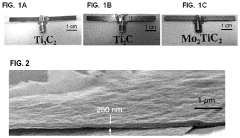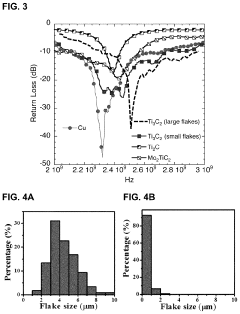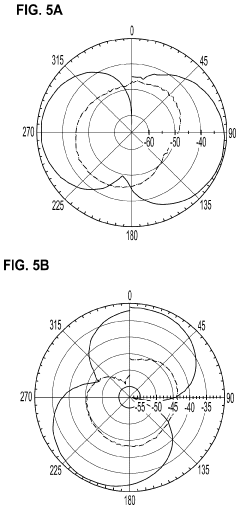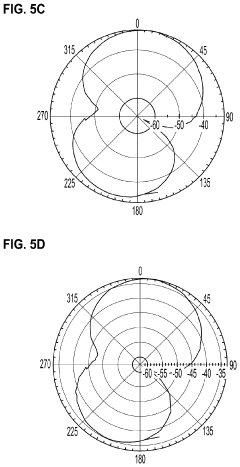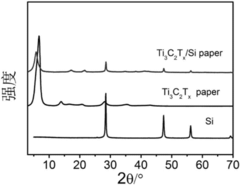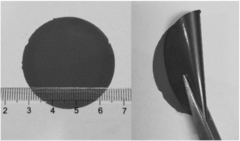MXene Integration into Augmented Reality Systems
AUG 8, 20259 MIN READ
Generate Your Research Report Instantly with AI Agent
Patsnap Eureka helps you evaluate technical feasibility & market potential.
MXene AR Integration Background and Objectives
MXene, a class of two-dimensional transition metal carbides and nitrides, has emerged as a promising material for various applications due to its unique properties. In the context of augmented reality (AR) systems, MXene integration represents a cutting-edge research direction with significant potential to revolutionize the field. The evolution of AR technology has been marked by continuous advancements in display technologies, sensors, and computing power. However, current AR systems face limitations in terms of energy efficiency, display quality, and overall performance.
The integration of MXene into AR systems aims to address these challenges and unlock new possibilities for immersive experiences. MXene's exceptional electrical conductivity, optical properties, and mechanical flexibility make it an ideal candidate for enhancing various components of AR devices. The primary objectives of this research are to explore the feasibility of incorporating MXene into AR displays, sensors, and power management systems, as well as to assess the potential improvements in performance, energy efficiency, and user experience.
One of the key areas of focus is the application of MXene in transparent conductive electrodes for AR displays. The material's high conductivity and optical transparency could lead to more efficient and brighter displays, potentially overcoming the limitations of current indium tin oxide (ITO) based electrodes. Additionally, MXene's potential in flexible electronics opens up possibilities for developing more ergonomic and adaptable AR devices that can conform to various form factors.
Another promising avenue for MXene integration is in the realm of sensors crucial for AR systems. The material's sensitivity to various stimuli, including light, pressure, and chemical compounds, could enable the development of more accurate and responsive sensors for tracking user movements, environmental conditions, and gesture recognition. This enhanced sensing capability could significantly improve the overall AR experience by providing more precise and immersive interactions.
Furthermore, MXene's exceptional electrochemical properties present opportunities for improving the power management and energy storage aspects of AR devices. The integration of MXene-based supercapacitors or batteries could potentially lead to longer-lasting and faster-charging AR systems, addressing one of the major limitations of current wearable AR technology.
As the field of AR continues to evolve, the integration of advanced materials like MXene is expected to play a crucial role in overcoming existing technological barriers and enabling new functionalities. This research aims to explore the full potential of MXene in AR systems, paving the way for next-generation devices that offer enhanced performance, improved user comfort, and more immersive experiences. By investigating the synergies between MXene's unique properties and the requirements of AR technology, this study seeks to contribute to the advancement of both materials science and augmented reality applications.
The integration of MXene into AR systems aims to address these challenges and unlock new possibilities for immersive experiences. MXene's exceptional electrical conductivity, optical properties, and mechanical flexibility make it an ideal candidate for enhancing various components of AR devices. The primary objectives of this research are to explore the feasibility of incorporating MXene into AR displays, sensors, and power management systems, as well as to assess the potential improvements in performance, energy efficiency, and user experience.
One of the key areas of focus is the application of MXene in transparent conductive electrodes for AR displays. The material's high conductivity and optical transparency could lead to more efficient and brighter displays, potentially overcoming the limitations of current indium tin oxide (ITO) based electrodes. Additionally, MXene's potential in flexible electronics opens up possibilities for developing more ergonomic and adaptable AR devices that can conform to various form factors.
Another promising avenue for MXene integration is in the realm of sensors crucial for AR systems. The material's sensitivity to various stimuli, including light, pressure, and chemical compounds, could enable the development of more accurate and responsive sensors for tracking user movements, environmental conditions, and gesture recognition. This enhanced sensing capability could significantly improve the overall AR experience by providing more precise and immersive interactions.
Furthermore, MXene's exceptional electrochemical properties present opportunities for improving the power management and energy storage aspects of AR devices. The integration of MXene-based supercapacitors or batteries could potentially lead to longer-lasting and faster-charging AR systems, addressing one of the major limitations of current wearable AR technology.
As the field of AR continues to evolve, the integration of advanced materials like MXene is expected to play a crucial role in overcoming existing technological barriers and enabling new functionalities. This research aims to explore the full potential of MXene in AR systems, paving the way for next-generation devices that offer enhanced performance, improved user comfort, and more immersive experiences. By investigating the synergies between MXene's unique properties and the requirements of AR technology, this study seeks to contribute to the advancement of both materials science and augmented reality applications.
AR Market Demand Analysis
The augmented reality (AR) market has been experiencing significant growth and transformation, driven by advancements in technology and increasing consumer demand. The integration of MXene into AR systems represents a potential breakthrough that could further accelerate market expansion and create new opportunities across various sectors.
The global AR market is projected to reach substantial value in the coming years, with a compound annual growth rate (CAGR) that outpaces many other tech sectors. This growth is fueled by the increasing adoption of AR technologies in industries such as gaming, entertainment, education, healthcare, and manufacturing. The demand for more immersive and interactive experiences is a key driver, with consumers and businesses alike seeking innovative solutions that blend digital information with the physical world.
In the consumer sector, AR applications for smartphones and wearable devices are gaining traction. The gaming and entertainment industries have been early adopters, with AR games and experiences attracting millions of users worldwide. Social media platforms are also integrating AR features, creating new avenues for user engagement and advertising opportunities.
The enterprise market for AR is showing robust growth potential, particularly in sectors such as manufacturing, healthcare, and retail. In manufacturing, AR is being used for training, maintenance, and quality control, leading to improved efficiency and reduced errors. The healthcare industry is leveraging AR for surgical planning, patient education, and medical training. Retailers are exploring AR for virtual try-ons and immersive shopping experiences, addressing the growing demand for personalized and interactive consumer journeys.
The integration of MXene into AR systems could address several key market demands. MXene's unique properties, including high electrical conductivity, mechanical strength, and flexibility, make it an attractive material for developing more advanced AR hardware. There is a growing need for lighter, more energy-efficient, and higher-performing AR devices, which MXene-based components could potentially deliver.
Moreover, the market is demanding AR systems with improved display quality, faster response times, and enhanced user comfort. MXene's potential applications in transparent electrodes, sensors, and energy storage devices align well with these requirements. The material's ability to enable flexible and wearable electronics could lead to the development of more ergonomic and user-friendly AR devices, addressing a significant pain point in current AR technology adoption.
As the AR market continues to evolve, there is an increasing emphasis on sustainability and environmental considerations. MXene's potential for creating more energy-efficient devices aligns with this trend, potentially opening up new market segments focused on eco-friendly AR solutions.
In conclusion, the AR market demonstrates strong demand across various sectors, with significant growth potential in both consumer and enterprise applications. The integration of MXene into AR systems could address several critical market needs, potentially driving further innovation and market expansion in this rapidly evolving technological landscape.
The global AR market is projected to reach substantial value in the coming years, with a compound annual growth rate (CAGR) that outpaces many other tech sectors. This growth is fueled by the increasing adoption of AR technologies in industries such as gaming, entertainment, education, healthcare, and manufacturing. The demand for more immersive and interactive experiences is a key driver, with consumers and businesses alike seeking innovative solutions that blend digital information with the physical world.
In the consumer sector, AR applications for smartphones and wearable devices are gaining traction. The gaming and entertainment industries have been early adopters, with AR games and experiences attracting millions of users worldwide. Social media platforms are also integrating AR features, creating new avenues for user engagement and advertising opportunities.
The enterprise market for AR is showing robust growth potential, particularly in sectors such as manufacturing, healthcare, and retail. In manufacturing, AR is being used for training, maintenance, and quality control, leading to improved efficiency and reduced errors. The healthcare industry is leveraging AR for surgical planning, patient education, and medical training. Retailers are exploring AR for virtual try-ons and immersive shopping experiences, addressing the growing demand for personalized and interactive consumer journeys.
The integration of MXene into AR systems could address several key market demands. MXene's unique properties, including high electrical conductivity, mechanical strength, and flexibility, make it an attractive material for developing more advanced AR hardware. There is a growing need for lighter, more energy-efficient, and higher-performing AR devices, which MXene-based components could potentially deliver.
Moreover, the market is demanding AR systems with improved display quality, faster response times, and enhanced user comfort. MXene's potential applications in transparent electrodes, sensors, and energy storage devices align well with these requirements. The material's ability to enable flexible and wearable electronics could lead to the development of more ergonomic and user-friendly AR devices, addressing a significant pain point in current AR technology adoption.
As the AR market continues to evolve, there is an increasing emphasis on sustainability and environmental considerations. MXene's potential for creating more energy-efficient devices aligns with this trend, potentially opening up new market segments focused on eco-friendly AR solutions.
In conclusion, the AR market demonstrates strong demand across various sectors, with significant growth potential in both consumer and enterprise applications. The integration of MXene into AR systems could address several critical market needs, potentially driving further innovation and market expansion in this rapidly evolving technological landscape.
MXene Technology Status and Challenges
MXene, a class of two-dimensional transition metal carbides and nitrides, has emerged as a promising material for integration into augmented reality (AR) systems. The current status of MXene technology in AR applications is characterized by rapid advancements and significant challenges. Researchers have made substantial progress in harnessing MXene's unique properties, such as high electrical conductivity, optical transparency, and mechanical flexibility, for AR devices.
One of the primary challenges in MXene integration is achieving consistent and scalable production methods. While laboratory-scale synthesis has shown promising results, transitioning to large-scale manufacturing remains a hurdle. The exfoliation process, crucial for obtaining single-layer MXene sheets, often results in variations in thickness and lateral size, affecting the material's performance in AR applications.
Another significant challenge lies in the long-term stability of MXene-based components in AR systems. MXene materials are susceptible to oxidation when exposed to air and moisture, potentially compromising their electrical and optical properties over time. Researchers are actively exploring various encapsulation techniques and surface modifications to enhance the stability and longevity of MXene-integrated AR devices.
The integration of MXene into transparent conductive electrodes for AR displays has shown great potential. However, achieving the optimal balance between transparency and conductivity remains a challenge. Current research focuses on developing novel MXene compositions and fabrication techniques to enhance both properties simultaneously.
In the realm of energy storage for AR devices, MXene-based supercapacitors have demonstrated promising results. The challenge lies in improving the energy density while maintaining the high power density characteristic of MXene materials. Researchers are investigating hybrid systems and composite materials to address this limitation.
Geographically, MXene research and development are concentrated in several key regions. The United States, China, and South Korea lead in patent filings and publications related to MXene technology. European countries, particularly Germany and the United Kingdom, are also making significant contributions to the field.
The current technological landscape for MXene in AR systems is marked by a race to overcome these challenges. Collaborative efforts between academic institutions and industry partners are driving innovation in material synthesis, device fabrication, and system integration. As research progresses, the focus is shifting towards addressing the scalability and reliability issues that currently limit the widespread adoption of MXene in commercial AR applications.
One of the primary challenges in MXene integration is achieving consistent and scalable production methods. While laboratory-scale synthesis has shown promising results, transitioning to large-scale manufacturing remains a hurdle. The exfoliation process, crucial for obtaining single-layer MXene sheets, often results in variations in thickness and lateral size, affecting the material's performance in AR applications.
Another significant challenge lies in the long-term stability of MXene-based components in AR systems. MXene materials are susceptible to oxidation when exposed to air and moisture, potentially compromising their electrical and optical properties over time. Researchers are actively exploring various encapsulation techniques and surface modifications to enhance the stability and longevity of MXene-integrated AR devices.
The integration of MXene into transparent conductive electrodes for AR displays has shown great potential. However, achieving the optimal balance between transparency and conductivity remains a challenge. Current research focuses on developing novel MXene compositions and fabrication techniques to enhance both properties simultaneously.
In the realm of energy storage for AR devices, MXene-based supercapacitors have demonstrated promising results. The challenge lies in improving the energy density while maintaining the high power density characteristic of MXene materials. Researchers are investigating hybrid systems and composite materials to address this limitation.
Geographically, MXene research and development are concentrated in several key regions. The United States, China, and South Korea lead in patent filings and publications related to MXene technology. European countries, particularly Germany and the United Kingdom, are also making significant contributions to the field.
The current technological landscape for MXene in AR systems is marked by a race to overcome these challenges. Collaborative efforts between academic institutions and industry partners are driving innovation in material synthesis, device fabrication, and system integration. As research progresses, the focus is shifting towards addressing the scalability and reliability issues that currently limit the widespread adoption of MXene in commercial AR applications.
Current MXene-AR Integration Solutions
01 MXene synthesis and composition
MXenes are two-dimensional transition metal carbides, nitrides, or carbonitrides with unique properties. They are typically synthesized by selective etching of MAX phases. The composition and structure of MXenes can be tailored for specific applications, offering a wide range of possibilities in material science and engineering.- MXene synthesis and composition: MXenes are a class of two-dimensional transition metal carbides, nitrides, or carbonitrides. They are synthesized by selective etching of certain atomic layers from MAX phase precursors. The composition and structure of MXenes can be tailored for specific applications, offering a wide range of properties suitable for various fields such as energy storage, electronics, and catalysis.
- Energy storage applications: MXenes show great potential in energy storage applications, particularly in supercapacitors and batteries. Their high surface area, excellent electrical conductivity, and ability to intercalate ions make them promising materials for improving energy density and charge-discharge rates in energy storage devices. Research focuses on optimizing MXene-based electrodes and electrolytes for enhanced performance.
- Electromagnetic interference shielding: MXenes exhibit excellent electromagnetic interference (EMI) shielding properties due to their high electrical conductivity and ability to absorb electromagnetic waves. They are being developed for use in lightweight, flexible, and efficient EMI shielding materials for electronic devices and aerospace applications. Research is ongoing to improve their shielding effectiveness and integration into composite materials.
- Environmental remediation and sensing: MXenes show promise in environmental applications, including water purification and gas sensing. Their high surface area and tunable surface chemistry allow for efficient adsorption of contaminants and selective detection of gases. Research is focused on developing MXene-based filters, membranes, and sensors for environmental monitoring and remediation purposes.
- Biomedical applications: MXenes are being explored for various biomedical applications, including drug delivery, tissue engineering, and biosensing. Their biocompatibility, photothermal properties, and ability to be functionalized make them attractive for targeted drug delivery systems and cancer therapy. Research is ongoing to develop MXene-based biomaterials and diagnostic tools for improved healthcare solutions.
02 Energy storage applications
MXenes show great potential in energy storage applications, particularly in supercapacitors and batteries. Their high electrical conductivity, large surface area, and ability to intercalate ions make them promising materials for improving energy density and charge-discharge rates in various energy storage devices.Expand Specific Solutions03 Electromagnetic interference shielding
MXenes exhibit excellent electromagnetic interference (EMI) shielding properties due to their high electrical conductivity and ability to absorb electromagnetic waves. This makes them suitable for use in electronic devices, aerospace applications, and other fields where EMI protection is crucial.Expand Specific Solutions04 Biomedical applications
MXenes show promise in various biomedical applications, including drug delivery, biosensing, and tissue engineering. Their biocompatibility, large surface area, and ability to be functionalized make them attractive for developing advanced medical technologies and treatments.Expand Specific Solutions05 Environmental remediation
MXenes demonstrate potential in environmental remediation applications, particularly in water purification and contaminant removal. Their high adsorption capacity, selectivity, and ability to be modified for specific pollutants make them effective materials for addressing environmental challenges.Expand Specific Solutions
Key Players in MXene and AR Industries
The research on MXene integration into augmented reality systems is in its early stages, with the market still emerging and showing significant growth potential. The technology is not yet fully mature, but rapid advancements are being made. Key players like Apple, Magic Leap, and Microsoft are investing heavily in AR development, while companies such as QUALCOMM and Murata Manufacturing are focusing on the materials and components side. Universities like Dalian University of Technology and Sun Yat-Sen University are contributing to fundamental research. The competitive landscape is diverse, with both established tech giants and innovative startups vying for market share in this promising field.
Apple, Inc.
Technical Solution: Apple's approach to integrating MXene into AR systems focuses on enhancing display technology and energy efficiency. They are developing MXene-based transparent conductive films for AR glasses, which offer improved conductivity and flexibility compared to traditional materials[1]. Apple is also exploring MXene's potential in battery technology, aiming to create more compact and longer-lasting power sources for AR devices. Their research includes incorporating MXene into flexible circuits and sensors to improve the overall form factor and performance of AR wearables[2]. Additionally, Apple is investigating MXene's electromagnetic shielding properties to reduce interference in AR systems, potentially improving signal quality and user experience[3].
Strengths: Strong R&D capabilities, extensive AR ecosystem, and potential for seamless integration with existing products. Weaknesses: High development costs and potential supply chain challenges for new materials.
Microsoft Technology Licensing LLC
Technical Solution: Microsoft's research on MXene integration in AR systems is centered around improving HoloLens technology. They are exploring MXene-based electrodes for more efficient and compact batteries, potentially extending the operational time of AR headsets[4]. Microsoft is also investigating MXene's potential in creating ultra-thin, flexible displays with enhanced brightness and contrast for improved AR visuals. Their approach includes developing MXene-based sensors for more accurate gesture recognition and environmental mapping in AR applications[5]. Additionally, Microsoft is researching MXene's thermal management properties to address heat dissipation issues in compact AR devices, potentially leading to more comfortable and longer-lasting wearables[6].
Strengths: Established presence in AR market with HoloLens, strong enterprise focus. Weaknesses: Limited consumer AR market share, potential challenges in miniaturization for everyday use.
Core MXene-AR Patents and Literature
Antennas comprising MX-ENE films and composites
PatentActiveUS11862847B2
Innovation
- The use of MXene films and composites as antenna materials, which can be produced as free-standing films and dispersed in various solvents, allowing for the creation of thin, flexible antennas with MXene compositions such as Ti3C2, Ti2C, and Mo2TiC2, applied to various substrates, including organic polymers and fabrics, to form monopole or dipole antennas.
Two-dimensional transition metal carbide (nitride)-nano silicon granular composite material as well as preparation and application thereof
PatentActiveCN107394180A
Innovation
- The two-dimensional transition metal carbon (nitride) MXene and nano-silicon particle composite materials are used, uniformly mixed by ultrasonic and vacuum filtration or freeze-drying to obtain a flexible composite film or composite powder, which can be used in the negative electrode of lithium-ion batteries to avoid adding conductive agents. and adhesive.
MXene-AR Performance Metrics
The integration of MXene into Augmented Reality (AR) systems presents a promising avenue for enhancing performance metrics across various aspects of AR technology. MXene, a class of two-dimensional transition metal carbides and nitrides, offers unique properties that can significantly impact AR system capabilities.
One of the primary performance metrics that MXene integration can improve is display quality. MXene-based transparent conductive films have demonstrated exceptional optical transmittance and electrical conductivity, which can lead to brighter, more responsive AR displays with improved contrast ratios. These enhancements contribute to a more immersive and visually appealing AR experience, potentially reducing eye strain during prolonged use.
Energy efficiency is another critical metric that stands to benefit from MXene integration. The material's high electrical conductivity and low resistance can lead to more efficient power consumption in AR devices. This improvement in energy efficiency translates to longer battery life and reduced heat generation, addressing two significant challenges in current AR hardware.
MXene's potential in electromagnetic interference (EMI) shielding is particularly relevant for AR systems. As AR devices often incorporate multiple wireless communication technologies, effective EMI shielding is crucial for maintaining signal integrity and preventing interference. MXene-based composites have shown superior EMI shielding effectiveness compared to traditional materials, which could lead to more reliable and robust AR systems.
The mechanical properties of MXene also contribute to enhanced durability and flexibility in AR hardware. MXene-reinforced polymers can provide improved strength and flexibility to AR device components, potentially leading to more resilient and adaptable form factors. This could enable the development of AR devices that are more comfortable to wear for extended periods and better suited to various environmental conditions.
In terms of sensing and input mechanisms, MXene's piezoresistive properties offer potential for developing highly sensitive touch and pressure sensors. These sensors could enable more precise and intuitive user interactions within AR environments, enhancing the overall user experience and expanding the range of possible applications for AR technology.
Thermal management is another area where MXene integration can improve AR system performance. The material's high thermal conductivity can facilitate more efficient heat dissipation, addressing the challenge of thermal buildup in compact AR devices. This improvement in thermal management can lead to more stable performance and increased device longevity.
One of the primary performance metrics that MXene integration can improve is display quality. MXene-based transparent conductive films have demonstrated exceptional optical transmittance and electrical conductivity, which can lead to brighter, more responsive AR displays with improved contrast ratios. These enhancements contribute to a more immersive and visually appealing AR experience, potentially reducing eye strain during prolonged use.
Energy efficiency is another critical metric that stands to benefit from MXene integration. The material's high electrical conductivity and low resistance can lead to more efficient power consumption in AR devices. This improvement in energy efficiency translates to longer battery life and reduced heat generation, addressing two significant challenges in current AR hardware.
MXene's potential in electromagnetic interference (EMI) shielding is particularly relevant for AR systems. As AR devices often incorporate multiple wireless communication technologies, effective EMI shielding is crucial for maintaining signal integrity and preventing interference. MXene-based composites have shown superior EMI shielding effectiveness compared to traditional materials, which could lead to more reliable and robust AR systems.
The mechanical properties of MXene also contribute to enhanced durability and flexibility in AR hardware. MXene-reinforced polymers can provide improved strength and flexibility to AR device components, potentially leading to more resilient and adaptable form factors. This could enable the development of AR devices that are more comfortable to wear for extended periods and better suited to various environmental conditions.
In terms of sensing and input mechanisms, MXene's piezoresistive properties offer potential for developing highly sensitive touch and pressure sensors. These sensors could enable more precise and intuitive user interactions within AR environments, enhancing the overall user experience and expanding the range of possible applications for AR technology.
Thermal management is another area where MXene integration can improve AR system performance. The material's high thermal conductivity can facilitate more efficient heat dissipation, addressing the challenge of thermal buildup in compact AR devices. This improvement in thermal management can lead to more stable performance and increased device longevity.
Environmental Impact of MXene in AR
The integration of MXene into Augmented Reality (AR) systems presents both opportunities and challenges from an environmental perspective. MXene, a two-dimensional material with exceptional electrical and mechanical properties, offers potential benefits in terms of energy efficiency and device performance. However, its production and disposal processes raise important environmental considerations.
MXene's unique properties allow for the development of more energy-efficient AR devices. The material's high conductivity and flexibility enable the creation of thinner, lighter, and more power-efficient displays and sensors. This can lead to reduced energy consumption in AR systems, potentially lowering their overall carbon footprint during operation. Additionally, the improved performance of MXene-based components may extend the lifespan of AR devices, reducing electronic waste generation.
However, the production of MXene involves chemical processes that may have environmental implications. The synthesis of MXene typically requires the use of strong acids and etching agents, which can generate hazardous waste if not properly managed. The environmental impact of these production processes needs to be carefully assessed and mitigated through the development of cleaner synthesis methods and effective waste treatment protocols.
The use of MXene in AR systems also raises concerns about end-of-life disposal and recycling. As MXene-enhanced AR devices become more prevalent, proper recycling and disposal methods must be established to prevent environmental contamination. The complex nature of MXene-integrated components may pose challenges for traditional recycling processes, necessitating the development of specialized recycling techniques to recover valuable materials and minimize environmental impact.
Furthermore, the potential release of MXene nanoparticles into the environment during the lifecycle of AR devices is an area that requires careful study. While MXene has shown promising biocompatibility in initial studies, the long-term effects of MXene nanoparticles on ecosystems and human health are not yet fully understood. Research into the environmental fate and potential toxicity of MXene is crucial to ensure the safe and sustainable integration of this material into AR technologies.
On a positive note, the enhanced durability and performance of MXene-based AR components could contribute to a reduction in electronic waste. By extending the useful life of AR devices and improving their resistance to wear and tear, MXene integration may help decrease the frequency of device replacements, thereby reducing the overall environmental impact associated with electronic device manufacturing and disposal.
In conclusion, the environmental impact of MXene in AR systems is a complex issue that requires a balanced approach. While the material offers potential benefits in terms of energy efficiency and device longevity, careful consideration must be given to its production processes, end-of-life management, and potential environmental risks. Ongoing research and development efforts should focus on optimizing the environmental performance of MXene-integrated AR systems throughout their entire lifecycle.
MXene's unique properties allow for the development of more energy-efficient AR devices. The material's high conductivity and flexibility enable the creation of thinner, lighter, and more power-efficient displays and sensors. This can lead to reduced energy consumption in AR systems, potentially lowering their overall carbon footprint during operation. Additionally, the improved performance of MXene-based components may extend the lifespan of AR devices, reducing electronic waste generation.
However, the production of MXene involves chemical processes that may have environmental implications. The synthesis of MXene typically requires the use of strong acids and etching agents, which can generate hazardous waste if not properly managed. The environmental impact of these production processes needs to be carefully assessed and mitigated through the development of cleaner synthesis methods and effective waste treatment protocols.
The use of MXene in AR systems also raises concerns about end-of-life disposal and recycling. As MXene-enhanced AR devices become more prevalent, proper recycling and disposal methods must be established to prevent environmental contamination. The complex nature of MXene-integrated components may pose challenges for traditional recycling processes, necessitating the development of specialized recycling techniques to recover valuable materials and minimize environmental impact.
Furthermore, the potential release of MXene nanoparticles into the environment during the lifecycle of AR devices is an area that requires careful study. While MXene has shown promising biocompatibility in initial studies, the long-term effects of MXene nanoparticles on ecosystems and human health are not yet fully understood. Research into the environmental fate and potential toxicity of MXene is crucial to ensure the safe and sustainable integration of this material into AR technologies.
On a positive note, the enhanced durability and performance of MXene-based AR components could contribute to a reduction in electronic waste. By extending the useful life of AR devices and improving their resistance to wear and tear, MXene integration may help decrease the frequency of device replacements, thereby reducing the overall environmental impact associated with electronic device manufacturing and disposal.
In conclusion, the environmental impact of MXene in AR systems is a complex issue that requires a balanced approach. While the material offers potential benefits in terms of energy efficiency and device longevity, careful consideration must be given to its production processes, end-of-life management, and potential environmental risks. Ongoing research and development efforts should focus on optimizing the environmental performance of MXene-integrated AR systems throughout their entire lifecycle.
Unlock deeper insights with Patsnap Eureka Quick Research — get a full tech report to explore trends and direct your research. Try now!
Generate Your Research Report Instantly with AI Agent
Supercharge your innovation with Patsnap Eureka AI Agent Platform!
